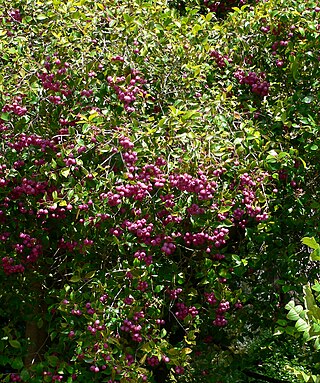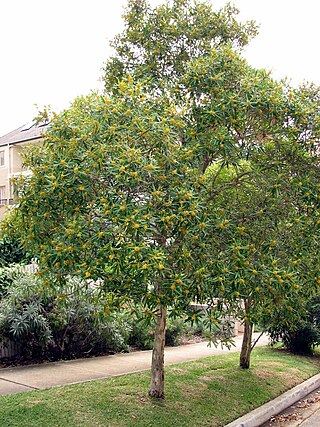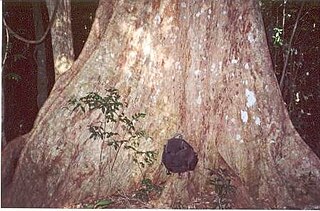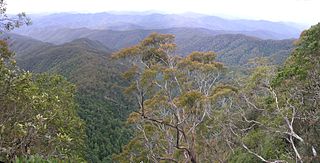
Deua is a national park located in New South Wales, Australia, 320 kilometres (200 mi) south of Sydney, and 100 kilometres (62 mi) east of Canberra. The nearest towns on the coast are Batemans Bay, Moruya and Narooma.

Leptospermum scoparium, commonly called mānuka, mānuka myrtle, New Zealand teatree, broom tea-tree, or just tea tree, is a species of flowering plant in the myrtle family Myrtaceae, native to New Zealand and south-east Australia. Its nectar produces Mānuka honey.
Gum tree is the common name of several trees and plants:

Tristania is a monotypic genus of flowering plants native to New South Wales, Australia, closely related to Thaleropia. The genus had a number of species, but some have been reclassified as Lophostemon and Tristaniopsis. The sole species currently in the genus is Tristania neriifolia. It is commonly known as the water gum.

Syzygium smithii is a summer-flowering, winter-fruiting evergreen tree, native to Australia and belonging to the myrtle family Myrtaceae. It shares the common name "lilly pilly" with several other plants.It is planted as shrubs or hedgerows, and features: rough, woody bark; cream and green smooth, waxy leaves; flushes of pink new growth; and white to maroon edible berries. Unpruned, it will grow about 3–5 m (9.8–16.4 ft) tall in the garden.

Kunzea ericoides, commonly known as kānuka, kanuka, or white tea-tree, is a tree or shrub in the myrtle family, Myrtaceae and is endemic to New Zealand. It has white or pink flowers similar to those of Leptospermum and from its first formal description in 1832 until 1983 was known as Leptospermum ericoides. The flowers have five petals and up to 25 stamens which are mostly longer than the petals.
The greater Brisbane area of Queensland Australia, has many species of indigenous flora. This article links the flora to its geography with:

Tristaniopsis laurina, the water gum or kanooka, is a tree species native to Australia. It usually grows near the eastern coastline and along the banks of streams, where the trunks and branches tend to be shaped in the direction of the current and give an indication of the flood height.

Syzygium francisii is a native Australian tree, common on the eastern sea board, between Morisset, New South Wales and Gladstone, Queensland. Common names include giant water gum, rose satinash, and Francis water gum. The habitat of Syzygium francisii is rainforest on basaltic or fertile alluvial soils.

Cumberland State Forest is a wet sclerophyll forest in Sydney, New South Wales, Australia. Situated on the southern edge of the Hornsby Plateau, the forest is located in the suburb of West Pennant Hills, Sydney and contains 40 hectares of native forest. It is the only metropolitan state forest in Australia and it is considered unique in comparison to the other state forests of NSW. The forest receives about 150,000 visitors annually.

Tristaniopsis collina, known as hill water gum or hill kanuka, is a tree of eastern Australia.

The Eastern Australian temperate forests is a broad ecoregion of open forest on uplands starting from the east coast of New South Wales in the South Coast to southern Queensland, Australia. Although dry sclerophyll and wet sclerophyll eucalyptus forests predominate within this ecoregion, a number of distinguishable rainforest communities are present as well.

The Booyong Flora Reserve is a protected nature reserve located in Booyong in the Northern Rivers region of New South Wales, Australia. The 13-hectare (32-acre) sub–tropical jungle is situated 18 kilometres (11 mi) northeast of Lismore and is a remnant of the Big Scrub, of which less than one percent of the original Big Scrub remains.
Victoria, Australia contains approximately 32,000 hectares of temperate rainforest in various regions, which represents 0.14% of the State's total area. The areas with rainforest include: East Gippsland, Strzelecki Ranges, Wilsons Promontory, Central Highlands, and Otway Ranges. The rainforests vary between cool temperate, warm temperate, and mixed cool temperate.

The Minyon Falls is a plunge waterfall on Repentance Creek in the Northern Rivers region of New South Wales, Australia. The waterfall descends more than 100 metres (330 ft) over the huge rhyolite cliffs which were once part of the Tweed Volcano. The water flow eroded the rocks to create the waterfall.

Mount Royal is situated at the southern end of the Mount Royal Range in the Barrington Tops region of eastern Australia. It is part of the World Heritage Gondwana Rainforests of Australia.

The Cumberland Plain Woodland, also known as Cumberland Plain Bushland and Western Sydney woodland, is a grassy woodland community found predominantly in Western Sydney, New South Wales, Australia, that comprises an open tree canopy, a groundcover with grasses and herbs, usually with layers of shrubs and/or small trees.

The ecology of Sydney, located in the state of New South Wales, Australia, is diverse for its size, where it would mainly feature biomes such as grassy woodlands or savannas and some sclerophyll forests, with some pockets of mallee shrublands, riparian forests, heathlands, and wetlands, in addition to small temperate and subtropical rainforest fragments.

Tristaniopsis exiliflora, the kanuka box, is a species of plant in the family Myrtaceae. It is found beside streams in Queensland, Australia, ranging from near the coast to 1,000 metres above sea level.















